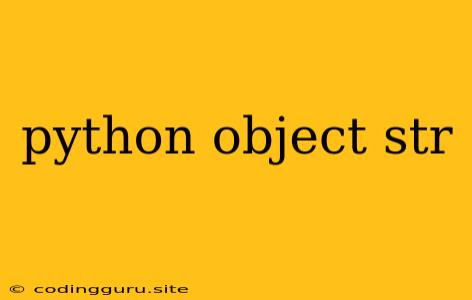Understanding Python's str Object: A Comprehensive Guide
In the world of Python programming, the str object is a fundamental building block for representing and manipulating text data. It serves as the foundation for everything from simple strings to complex text processing. This guide will explore the str object in depth, offering a comprehensive understanding of its properties, methods, and practical applications.
What is a str Object?
In Python, a str object is an immutable sequence of characters. This means that once a str object is created, its contents cannot be changed directly. Instead, any modification results in the creation of a new str object. This immutability ensures that strings are consistent and predictable, which is crucial for reliable data handling.
Creating str Objects
Creating str objects in Python is incredibly simple. You can use single quotes ('), double quotes ("), or triple quotes (''' or """) to enclose the desired sequence of characters.
# Single quotes
my_string = 'This is a string.'
# Double quotes
another_string = "This is another string."
# Triple quotes for multi-line strings
multi_line_string = """This is a multi-line
string that spans across
multiple lines."""
Essential str Methods
Python's str object comes equipped with a rich set of methods that empower you to manipulate and analyze text effectively. Let's explore some of the most commonly used methods:
len(string): This built-in function returns the length of the string, indicating the number of characters it contains.
my_string = "Hello World"
length = len(my_string)
print(length) # Output: 11
string.upper(): Converts all characters in the string to uppercase.
my_string = "hello world"
uppercase_string = my_string.upper()
print(uppercase_string) # Output: HELLO WORLD
string.lower(): Converts all characters in the string to lowercase.
my_string = "HELLO WORLD"
lowercase_string = my_string.lower()
print(lowercase_string) # Output: hello world
string.strip(): Removes leading and trailing whitespace characters from the string.
my_string = " Hello World "
stripped_string = my_string.strip()
print(stripped_string) # Output: Hello World
string.replace(old, new): Replaces all occurrences of theoldsubstring with thenewsubstring.
my_string = "Hello World"
replaced_string = my_string.replace("World", "Universe")
print(replaced_string) # Output: Hello Universe
string.split(separator): Splits the string into a list of substrings based on the specifiedseparator. If no separator is provided, whitespace characters are used by default.
my_string = "apple,banana,orange"
fruit_list = my_string.split(",")
print(fruit_list) # Output: ['apple', 'banana', 'orange']
string.join(iterable): Concatenates the elements of an iterable (e.g., list, tuple) into a single string, separated by the string itself.
fruit_list = ['apple', 'banana', 'orange']
joined_string = ", ".join(fruit_list)
print(joined_string) # Output: apple, banana, orange
string.find(substring): Returns the lowest index in the string where thesubstringis found. If thesubstringis not found, it returns -1.
my_string = "Hello World"
index = my_string.find("World")
print(index) # Output: 6
string.startswith(prefix): Checks if the string starts with the specifiedprefix. ReturnsTrueif it does,Falseotherwise.
my_string = "Hello World"
result = my_string.startswith("Hello")
print(result) # Output: True
string.endswith(suffix): Checks if the string ends with the specifiedsuffix. ReturnsTrueif it does,Falseotherwise.
my_string = "Hello World"
result = my_string.endswith("World")
print(result) # Output: True
Working with str Objects: Practical Examples
The str object is highly versatile and finds applications in a wide range of tasks. Here are some practical examples:
1. Formatting Strings:
name = "Alice"
age = 30
message = f"My name is {name} and I am {age} years old."
print(message) # Output: My name is Alice and I am 30 years old.
2. Text Analysis:
text = "This is a sample text for analysis."
word_count = len(text.split())
print(word_count) # Output: 7
3. Data Extraction:
data = "Name: John Doe, Age: 35, City: New York"
name = data.split(",")[0].split(":")[1].strip()
age = data.split(",")[1].split(":")[1].strip()
city = data.split(",")[2].split(":")[1].strip()
print(f"Name: {name}, Age: {age}, City: {city}")
4. Validation:
email = "[email protected]"
if "@" in email and "." in email:
print("Valid email address")
else:
print("Invalid email address")
Conclusion
The str object is a fundamental data type in Python that empowers you to work with text data in a highly effective manner. From basic string manipulation to sophisticated text analysis, understanding the str object and its methods is essential for building robust and versatile Python applications.
